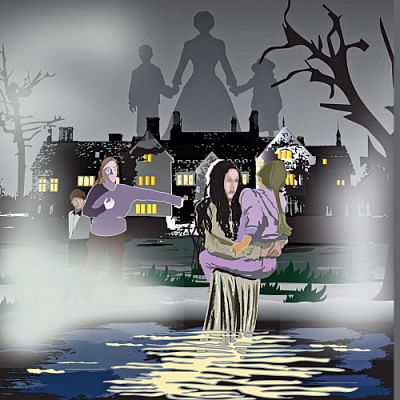“It’s you, it’s me, it’s us”: Bly Manor’s Homage to Henry James

Effigies with their own minds, tinkling music boxes, mysterious cracks in the wall, and a long-haired spectre trailing the grounds of a vast, echoing mansion in her deathbed nightgown—the Gothic horror story is well and alive in 2020 in Mike Flanagan's The Haunting of Bly Manor, the follow-up to the wildly popular 2018 Netflix series The Haunting of Hill House.
While Hill House revived the eponymous novel by Shirley Jackson, Bly Manor is adapted from a few different works of the horror pioneering 19th-century American author Henry James—a significant source of inspiration for Jackson herself—with his 1898 novella The Turn of the Screw at the centre of the narrative.
The Haunting of Bly Manor, as in The Turn of the Screw, features as its primary protagonist a governess, called Dani Clayton in the show, who arrives at Bly to take on the care of the orphaned Miles and Flora Wingrave. With their absent, troubled uncle as their only guardian, the children's family is made up of only the inhabitants and employees of Bly. Soon after her arrival, Dani starts to suspect that the place is haunted by two former employees of the manor.
For fans of Flanagan's earlier project, the ghosts and tragedies of Bly might seem tame in comparison to the jump-scares and tangibly thrilling action of Hill House; here, they are swapped out for psychology and atmosphere. The narrative drags at some points, with overly sentimental dialogue, convoluted screenplay, a few anticlimactic build-ups and, yes, some bad acting. But what makes Bly Manor special is the homage it pays to the very specifically psychotic Gothic horror that James explored in his work.
The Turn of the Screw is not an easy read. Most of its seemingly never-ending passages are dedicated solely to mapping the governess's internal conflicts, with little space for actual plot development. The story shuffles along at a snail's pace that might be considered ill-suited to its genre. And yet, it's bone-chilling.
"I remember the whole beginning as a succession of flights and drops," recounts the unnamed governess in Screw, "a little seesaw of the right throbs and the wrong." Inside the great manor, against an idyllic backdrop and beneath the bright-eyed innocence of the orphaned children shift the currents of centuries-old secrets. The governess is faced with new, increasingly existential questions every day, while the reader can't but wonder whether it's not her sanity that should be questioned. Psychotic and impressionistic, James's stories lead the reader through such mental mazes, where the real terror that rears its head is perception or knowledge itself. The resulting feeling is, of course, entrapment. And trapped is exactly what the inhabitants of Flanagan's Bly Manor are as well, whether they are living or dead.
Dani, the au pair at Bly, battles demons from her past while trying to decode the increasingly strange behaviour of her charges Flora and Miles. Owen is stuck at his post as cook while caring for his dementia-afflicted mother. And Hannah Grose, the housekeeper, is shut up in a time loop that contains perhaps the scariest of secrets embedded in her story.
Such entrapment is a state we can all relate to in the current time, stagnating in Netflix-binging loops, monotonous domestic routines and stale interactions—a collective inertia that forces us into the corners of our minds, where memories of happier, easier times taunt us, making us wonder if things ever really were that good. In that sense, with regret as its central theme, Bly resonates deeply. It charts precisely the ways in which rage and loneliness have the power to efface and erase us if we give into the sense that they are never-ending.
"We can't count on the past," says a drunken Owen as he and Hannah sit by a campfire at one point in the show. "We think we have it trapped in our memories… but memories fade." Hannah finds herself returning to this memory time and again, reliving it differently each time. In another part of the house, little Flora sighs in her sleep as she realizes: "It's happening again. I'm tucked away in another memory."
The Haunting of Bly Manor might not be the scariest horror story there is, but it's certainly one of the most heart breaking. Even as it diverges from its source material, it stays true to the lesson contained in James's novella, which is to explore the way memories trap us and regret ensnares us if we don't do our best to move forward. Hopefully, the viewer comes away with something of the notion that there is solace to be found, in words like Jamie, the gardener's: "The fear of losing someone shouldn't stop us from loving them."
Shehrin Hossain is a graduate of English literature from North South University. Email: [email protected]

 For all latest news, follow The Daily Star's Google News channel.
For all latest news, follow The Daily Star's Google News channel. 



Comments